In Jack Vance’s The Languages of Pao, an off-worlder named Palafox has a plan to save Pao. The Paonese, it seems, keep getting bullied by the Brumbo Clan from the planet Batmarsh, on account of their cultural passivity. According to Palafox, though, the root cause of the problem is the language that all Paonese share. In order to rectify the situation, Palafox hatches a preposterously circuitous plan, whereby he will create three new languages for the Paonese, each designed to elicit a certain characteristic response from its speakers. One of these languages will be a “warlike” language that will turn all its speakers into soldiers; another will enhance the intellectual capabilities of its speakers; the third will produce a master class of merchants. Once different segments of Pao’s population have adopted these languages as their own, the resultant cultural diversity will allow the Paonese to defend themselves against all comers.
The premise of this book is pure fantasy and has absolutely no grounding in linguistic science. Often when an author decides to incorporate language into their work, the results are similar, whether the story is entertaining or not. Certain authors, though, have managed to weave language into their work in a realistic and/or satisfying way. Below are five books or series that I think have done a particularly good job with their invented languages.
J.R.R. Tolkien, The Lord of the Rings Trilogy
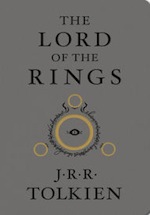 Let’s get the easy one out of the way first. Tolkien was, before anything else, a language creator, and we haven’t yet seen another work where the skill and depth of the invented languages employed therein equaled the quality of the work itself. The Elvish languages of Arda predated the works set in Middle-earth by decades, and though we don’t see a lot of examples in the books, every single detail ties in to Tolkien’s greater linguistic legendarium as a whole. There have been better books since Tolkien’s—and better constructed languages—but we have yet to see a combination that rivals Tolkien’s works, and I doubt we will for some time.
Let’s get the easy one out of the way first. Tolkien was, before anything else, a language creator, and we haven’t yet seen another work where the skill and depth of the invented languages employed therein equaled the quality of the work itself. The Elvish languages of Arda predated the works set in Middle-earth by decades, and though we don’t see a lot of examples in the books, every single detail ties in to Tolkien’s greater linguistic legendarium as a whole. There have been better books since Tolkien’s—and better constructed languages—but we have yet to see a combination that rivals Tolkien’s works, and I doubt we will for some time.
George R. R. Martin, A Song of Ice and Fire
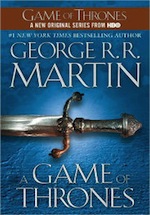 Moving from Tolkien to George R. R. Martin, who created no languages for his A Song of Ice and Fire series, might seem like a step back, but there is a key trait that ties Tolkien’s and Martin’s works together. Though you’ll often hear it said, Tolkien’s elves do not, in fact, speak “Elvish”—no more than those currently living in Italy, Spain and France speak “Latin.” Instead, some of the elves speak Sindarin, which itself has four dialects, while others speak Quenya, which has two dialects, all of which are descended from a common ancestor, Primitive Quendian. And then, of course, there are languages for beings other than the elves, as well.
Moving from Tolkien to George R. R. Martin, who created no languages for his A Song of Ice and Fire series, might seem like a step back, but there is a key trait that ties Tolkien’s and Martin’s works together. Though you’ll often hear it said, Tolkien’s elves do not, in fact, speak “Elvish”—no more than those currently living in Italy, Spain and France speak “Latin.” Instead, some of the elves speak Sindarin, which itself has four dialects, while others speak Quenya, which has two dialects, all of which are descended from a common ancestor, Primitive Quendian. And then, of course, there are languages for beings other than the elves, as well.
This is the linguistic diversity we see in the real world that we rarely see in fantasy—and we see it too in George R. R. Martin’s work, where High Valyrian begat the Bastard Valyrian tongues, and where a realistic contact situation in Slaver’s Bay produces a modern mixed language from varying sources. Even though the languages weren’t worked out in detail, their genetic histories were, and these were done masterfully. For authors who don’t want to create a language on their own, or who don’t wish to hire a seasoned conlanger to create one for them, I recommend Martin’s work as a model of the right way to incorporate linguistic elements into high fantasy.
Suzette Haden Elgin, Native Tongue
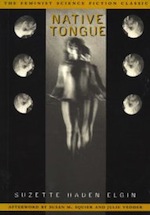 In Native Tongue, Suzette Haden Elgin imagined a group of women trapped in a patriarchal society creating a language that would liberate them mentally and physically from male oppression. The idea that language by itself can effect change is, as mentioned previously, science fantasy, but unlike Jack Vance, Suzette Haden Elgin actually created the language she describes in her books. It’s called Láadan, and though it didn’t really catch on with women in the real world the way she hoped it would, the effort was an extraordinary one and stands as a rare achievement for an author tackling a linguistic subject in their work.
In Native Tongue, Suzette Haden Elgin imagined a group of women trapped in a patriarchal society creating a language that would liberate them mentally and physically from male oppression. The idea that language by itself can effect change is, as mentioned previously, science fantasy, but unlike Jack Vance, Suzette Haden Elgin actually created the language she describes in her books. It’s called Láadan, and though it didn’t really catch on with women in the real world the way she hoped it would, the effort was an extraordinary one and stands as a rare achievement for an author tackling a linguistic subject in their work.
Vladimir Nabokov, Pale Fire
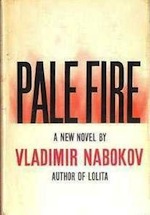 Though Nabokov didn’t create a full language for Pale Fire, he created an interesting sketch of what we today would call an a posteriori language—a language based on real world sources. In Pale Fire, Nabokov follows the exiled former ruler of an imaginary country called Zembla, but even within the fictional context of the story, it’s not quite certain how “real” Zembla is supposed to be. One gets the same slightly unsettling sense from the Zemblan language, which at turns looks plausibly Indo-European, or completely ridiculous. Though used sparingly, the conlang material enhances the overall effect of the work, adding another level of mystery to the already curious text.
Though Nabokov didn’t create a full language for Pale Fire, he created an interesting sketch of what we today would call an a posteriori language—a language based on real world sources. In Pale Fire, Nabokov follows the exiled former ruler of an imaginary country called Zembla, but even within the fictional context of the story, it’s not quite certain how “real” Zembla is supposed to be. One gets the same slightly unsettling sense from the Zemblan language, which at turns looks plausibly Indo-European, or completely ridiculous. Though used sparingly, the conlang material enhances the overall effect of the work, adding another level of mystery to the already curious text.
Kurt Vonnegut, Cat’s Cradle
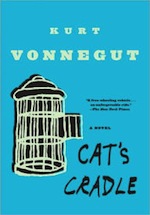 In Cat’s Cradle, Vonnegut introduces the reader to the island nation of San Lorenzo, whose culture, government, and religion were radically altered by the actions of two castaways who washed ashore one day. Central to the religion, called Bokononism, are a series of English-like words that were introduced to the island by English speakers, and then altered in quasi-realistic ways. For example, karass, likely from English “class,” is a group of people that are cosmically connected in an indiscernible way. From that word, though, comes the word duprass: A karass consisting of exactly two people. This is precisely the type of fascinating misanalysis that occurs all the time in real word borrowings, such as the English word “tamale,” formed by taking the “s” off “tamales,” even though the word for one tamale in Spanish is tamal.
In Cat’s Cradle, Vonnegut introduces the reader to the island nation of San Lorenzo, whose culture, government, and religion were radically altered by the actions of two castaways who washed ashore one day. Central to the religion, called Bokononism, are a series of English-like words that were introduced to the island by English speakers, and then altered in quasi-realistic ways. For example, karass, likely from English “class,” is a group of people that are cosmically connected in an indiscernible way. From that word, though, comes the word duprass: A karass consisting of exactly two people. This is precisely the type of fascinating misanalysis that occurs all the time in real word borrowings, such as the English word “tamale,” formed by taking the “s” off “tamales,” even though the word for one tamale in Spanish is tamal.
This article was originally published in September 2015.
David Peterson holds an M.A. in linguistics from UC San Diego. He’s been creating languages since 2000, and is one of the founders of the Language Creation Society. Perhaps his best known work is with HBO’s Game of Thrones, where he developed the Dothraki and Valyrian languages. His latest book, The Art of Language Invention, is available from Penguin Books.











I think about languages in my writing of aliens and fantasy critters but I mostly stick to names rather than whole languages. It was also interesting to learn the singular of tamales is tamal in Spanish.
(Besides Quenya, Sindarin and Khuzdul, of course, duh!) I instantly thought about the Wheel of Time and the Old Tongue there. Considering the length of the Old Tongue – English dictionary in the Wheel of Time Companion, it really is noteworthy.
Another examples I thought of are the Inheritance books by Paolini (though to a lesser degree), and also the Moorehawke trilogy by Celine Kiernan. The Merron in Kiernan’s books have their own beautoful language, alhtough I undertand Kiernan used Irish for this (I might have misunderstood, though).
Edit: Me and my typos. Beautoful, alhtough, undertand? *sighs* That’s what happens when you hurry back to watching something good after the commercial break and hit “send” before actually reading what your fingers have done. Apologies.
Two classics:
A Clockwork Orange by Anthony Burgess, and Riddley Walker by Russell Hoban.
Well, it’s a play, and the languages aren’t realistic as far as I know, but I can’t resist mentioning “The Memorandum” by Vaclav Havel, in which a memorandum, written in an artificial language, is sent to members of an organization.
Embassytown by China Miéville absolutely should have been on this list. Nothing in the whole Song of Ice and Fire matches the linguistic speculation in this book. It is a masterpiece.
Babel-17 by Samuel Delany.
Janny Wurts in her Wars of Light and Shadow also comes to mind
@6/PamAdams: That wasn’t a realistic language.
In “The Moon Is a Harsh Mistress” Robert Heinlein has the narrator speaking a version of English laced with Russian and Chinese words as well as Australian slang.
In “The Wheels of If”, set in a world where the Norman Conquest never occurred and Anglo-Celtic-Vikings colonized North America, Sprague de Camp imagines a version of English without the Norman-French/Latinate influence.
Arthur C. Clarke’s 2010 featured “Russlish” :D
Can’t help but think of the Kingkiller Chronicle, also. Complete with cool language ideas like ‘wine only has a vintage if it’s from Vintas’. Rothfuss didn’t exactly develop his languages to the point of selling lexicons or anything, but they are rich and full, with scope of history and fading and blending and all that good stuff for which I don’t have technical terms.
Of course stories where languages change people are taking the Sapir-Whorf-hypothesis literally.
Tolkien’s Elvish languages are actually problematic because their linguistic history doesn’t take the elves’ long lives into account.
I agree with PHalyard @@@@@ 5 about Embassytown. That book is so jam packed with cool concepts that one overlooks the brilliance of the way he explores language and idioms and metaphors.
I think we have to understand that making up lots of words that sort of sound like misspelt words we might have come across in English or in other stories does not constitute a sophisticated linguistic background for a work </grumpy> On the other hand, Tolkien understood enough about the linguistic background of his sub-creation that the very place names reflect layers of history and language, just as they do in the UK. So Bree and Archet are linguistically different from Hobbiton or Bywater.
I think Ursula LeGuin says somewhere that when writing Earthsea she knew enough about the Old Tongue that she could construct sentences in it, though there are few examples in the works.
My favorite example of this is Ascian from Gene Wolfe’s Book of the New Sun. The chapter in which Foila interprets Loyal to the Group of Seventeen’s tale into the idiom of the Commonwealth gives me goosebumps:
“In times past, loyalty to the cause of the populace was to be found everywhere. The will of the Group of Seventeen was the will of everyone.”
“Once upon a time…”
What always bothered me about Native Tongue, and Laadan, is that while the author identified critical gaps in the English language (e.g. the lack of a good active verb for a woman’s role in heterosexual penetrative [PIV] sex), she never really addressed those gaps in the books. Instead, we get tidbits like the word for “mule” being “wise animal”, or the translation of “he anoints my head with oil” to “she braids my hair with her own hands.”
English is a magpie language. If she’d invented vocabulary and introduced it, for the gaps she saw as a problem, people may have picked it up, or gone on to work out alternative solutions, as we see people doing with “zie” or “they” instead of “he” for a gender neutral pronoun.
Wanting women to adopt a new language to address a limited number of gaps in the vocabulary seems excessive.
I’ve wondered why authors and TV/movie producers haven’t used the diversity of threatened _real_ languages instead of creating their own; the Endangered Languages Project lists over 3000 of them. Having Dothraki speakers on TV use an actual endangered language from the steppes of Eurasia might help preserve that language…
@17 – Making up nonsense to be a fictional language is cheap. Getting someone to learn an endangered language well enough to write it in a TV/movie script is expensive and time consuming.
Plus, the problem of endangered languages isn’t one of just the words. It’s one of cultural change and, quite often, cultural aggression. Using the language in a movie or TV show in the US wouldn’t do anything to preserve the culture the language comes from.
And taking a language spoken by real people, out of its context, and presenting it as, say, the language of an invading alien race, is rather problematic. It quite literally dehumanizes the language. It treats the language as a toy of powerful outsiders, rather than the birthright of those born to parents who speak it.
It is similar to the problem of Christian missionaries seeking out and learning obscure (to the West) languages, with the goal of translating the Bible into that language and converting and “civilizing” the native speakers.
No comment on Newspeak from 1984, interesting.